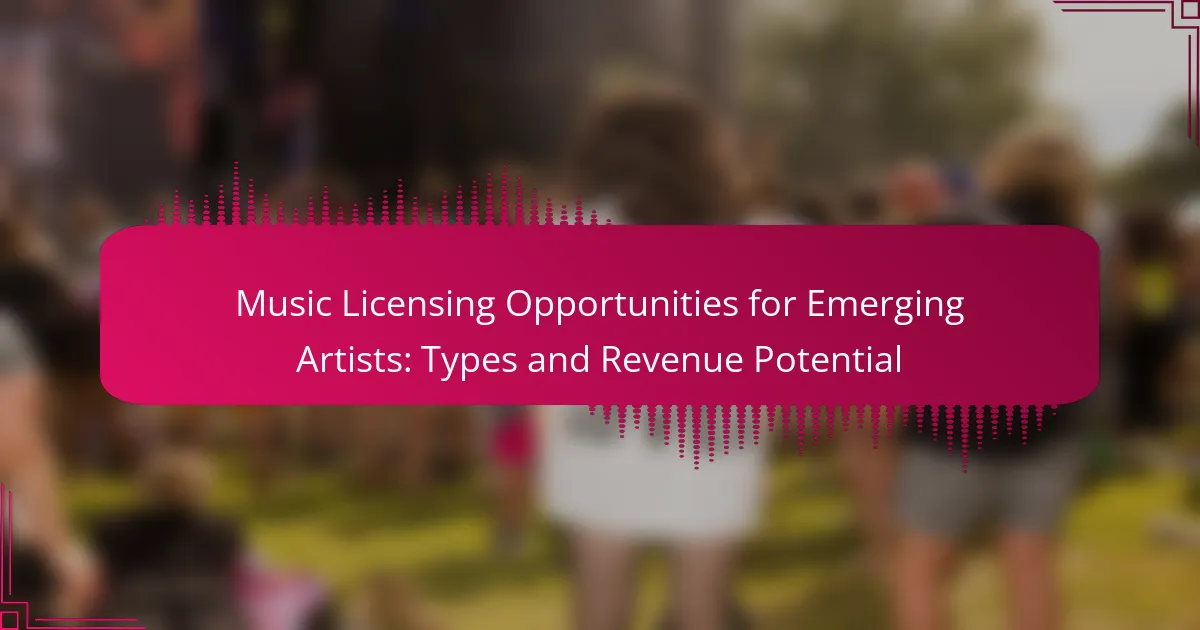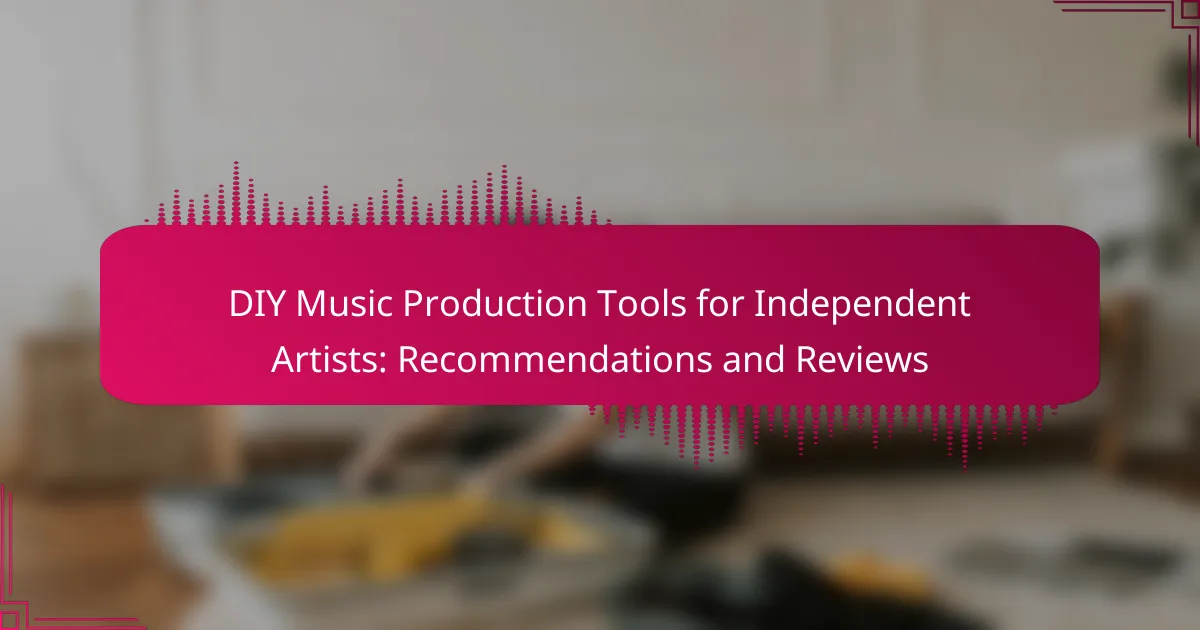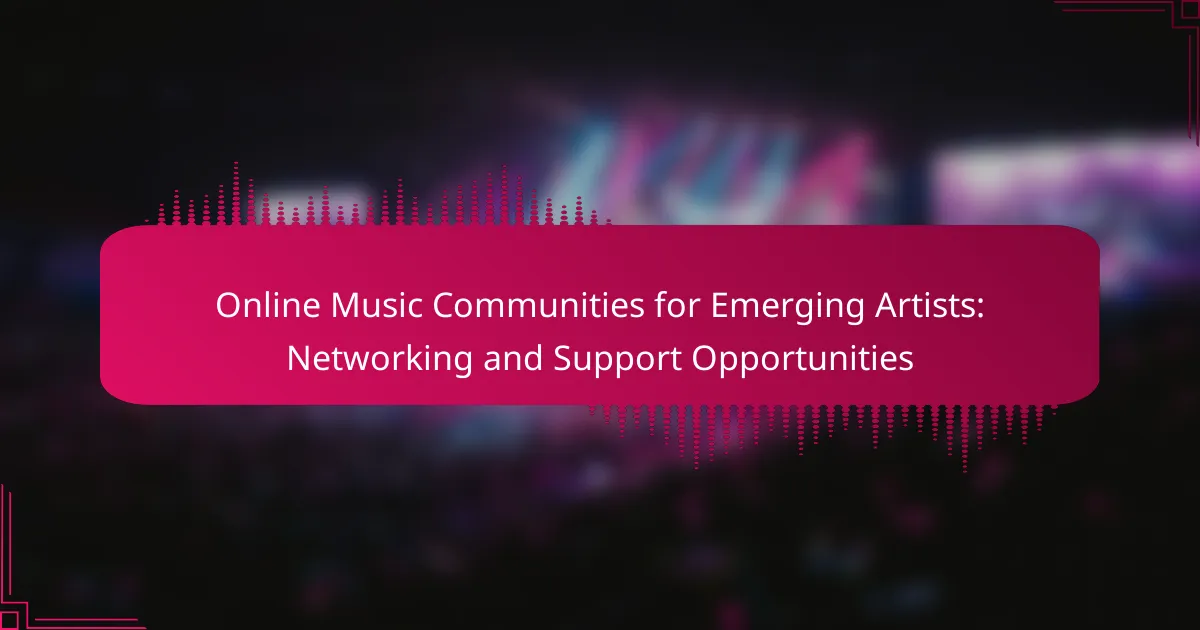Independent musicians often struggle to engage their audience effectively on social media. This article explores techniques like content creation, interactive posts, and live performances. It also emphasizes the importance of analytics in refining strategies. Collaborations and authentic storytelling are highlighted as methods to foster community and build a loyal fan base.
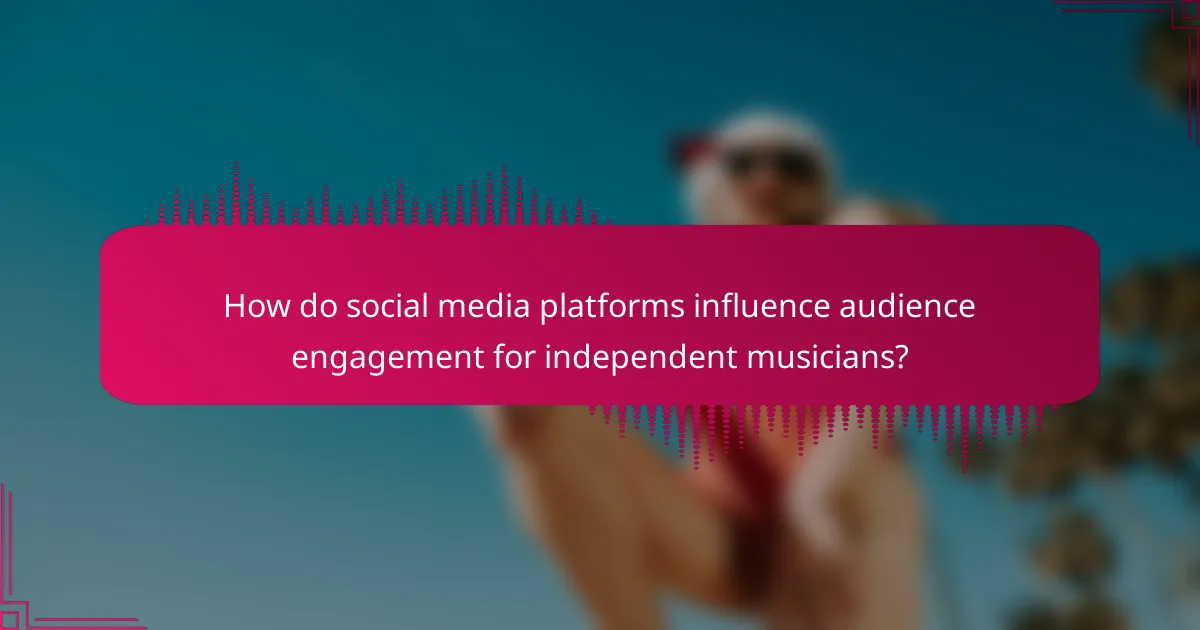
How do social media platforms influence audience engagement for independent musicians?
Social media platforms significantly enhance audience engagement for independent musicians through targeted marketing techniques. These techniques include content creation, audience interaction, and data analytics.
Independent musicians can use visually appealing content, like videos and images, to attract followers. Engaging storytelling about their music journey fosters a connection with the audience. Regularly posting updates and behind-the-scenes content keeps fans interested.
Interacting with followers through comments and messages builds a loyal community. Hosting live sessions allows musicians to engage directly, creating a personal touch that encourages audience participation.
Utilizing analytics tools helps musicians understand their audience’s preferences. By analyzing engagement metrics, they can refine their content strategies to better resonate with fans, ultimately enhancing overall engagement.
Which social media platforms are most effective for independent musicians?
Independent musicians find platforms like Instagram, TikTok, and YouTube most effective for audience engagement. These platforms offer unique features that enhance visibility and interaction.
Instagram provides visual storytelling through posts and stories, allowing musicians to showcase their creativity. TikTok’s algorithm promotes viral content, enabling independent artists to reach a broader audience quickly. YouTube serves as a robust platform for music videos, tutorials, and live performances, fostering deeper connections with fans.
Utilizing these platforms strategically can significantly boost an independent musician’s reach and engagement levels.
What are the key audience demographics on different social media platforms?
Different social media platforms attract distinct audience demographics. Facebook has a diverse user base, predominantly aged 25-34. Instagram appeals to younger audiences, with 67% of users aged 18-29. Twitter’s users are primarily between 30-49, while TikTok skews younger, with 60% of users aged 16-24. LinkedIn targets professionals, with 51% of users aged 25-34. YouTube attracts a broad range, with significant engagement across all age groups. Understanding these demographics helps independent musicians tailor their engagement strategies effectively.
How does platform choice affect content strategy for musicians?
Platform choice significantly impacts content strategy for musicians by determining audience reach and engagement methods. Different platforms cater to distinct demographics and content formats, shaping how musicians interact with fans. For instance, Instagram excels in visual storytelling, while TikTok thrives on short, engaging videos.
Musicians must analyze platform analytics to understand audience preferences. For example, Facebook’s user base skews older, making it suitable for targeting established fans. In contrast, platforms like Snapchat and TikTok attract younger audiences, ideal for emerging artists.
The choice of platform also influences content frequency and style. Regular posts on Twitter can enhance real-time engagement, while polished videos on YouTube can build a professional image. As a result, selecting the right platform aligns with the musician’s brand identity and goals.
Ultimately, a well-considered platform strategy enhances audience engagement, fostering a loyal fan base and driving career growth.

What types of content drive engagement for independent musicians?
Social media marketing techniques that drive engagement for independent musicians include interactive content, live performances, and user-generated content. These strategies enhance audience connection and foster community.
1. Interactive content: Polls and quizzes engage followers and encourage participation.
2. Live performances: Streaming concerts allows real-time interaction and boosts visibility.
3. User-generated content: Encouraging fans to share their experiences creates organic promotion.
4. Consistent branding: A cohesive visual and thematic identity strengthens recognition and loyalty.
5. Collaborations: Partnering with other artists expands reach and introduces new audiences.
Which formats (videos, images, live streams) resonate most with audiences?
Videos resonate most with audiences, followed by images and live streams. Videos engage viewers through storytelling and dynamic content. Research shows that video content generates 1200% more shares than text and images combined. Images attract attention quickly but lack the depth of videos. Live streams create real-time interaction, fostering community but may not have the same reach as pre-recorded videos. Each format serves unique engagement strategies for independent musicians.
How can storytelling enhance audience connection?
Storytelling enhances audience connection by creating emotional resonance and relatability. It allows independent musicians to share personal journeys, fostering a deeper bond with listeners. Engaging narratives can evoke feelings, making the audience feel invested in the artist’s experiences. This connection often leads to increased loyalty and community among fans, enhancing overall engagement. By using storytelling techniques, musicians can differentiate themselves in a crowded market, showcasing unique attributes that resonate with their audience.
What role do hashtags and trends play in content visibility?
Hashtags and trends significantly enhance content visibility for independent musicians by increasing discoverability. Utilizing relevant hashtags connects posts to wider conversations, attracting new audiences. Trends can amplify engagement by aligning content with current interests, making it more likely to be shared. Effective hashtag strategies can lead to higher interaction rates, ultimately expanding a musician’s reach.

How can independent musicians build their brand on social media?
Independent musicians can build their brand on social media by consistently engaging with their audience. They should utilize platforms like Instagram, TikTok, and Twitter to share authentic content, behind-the-scenes glimpses, and personal stories.
Establishing a unique visual identity enhances recognition. Musicians should use eye-catching graphics and cohesive themes across posts. Collaborating with other artists and influencers can expand reach and introduce new audiences.
Regularly interacting with fans through comments, live sessions, and Q&A can foster loyalty. Musicians should also analyze engagement metrics to refine their strategies.
Utilizing tools like scheduled posts and analytics can streamline efforts. By maintaining a consistent online presence, independent musicians can effectively grow their brand and connect with their audience.
What are the essential elements of a musician’s social media profile?
A musician’s social media profile should include a professional profile picture, engaging bio, links to music platforms, consistent branding, and regular content updates. These elements foster audience connection and enhance visibility.
| Element | Description |
|————————-|————————————————–|
| Profile Picture | Clear, professional image representing the musician |
| Engaging Bio | Brief, compelling summary of the musician’s style and achievements |
| Links to Music Platforms | Direct connections to streaming services and music videos |
| Consistent Branding | Uniform visuals and messaging across all platforms |
| Regular Content Updates | Frequent posts to keep the audience engaged and informed |
How does consistent branding across platforms impact audience perception?
Consistent branding across platforms enhances audience perception by fostering trust and recognition. When independent musicians maintain uniform visuals and messaging, they create a cohesive identity that resonates with fans. This consistency leads to increased engagement, as audiences are more likely to connect with familiar brands. A study found that 75% of consumers recognize a brand based on its visual identity alone. Additionally, consistent branding across social media platforms can improve overall brand loyalty, as followers feel a stronger affiliation with a recognizable entity.
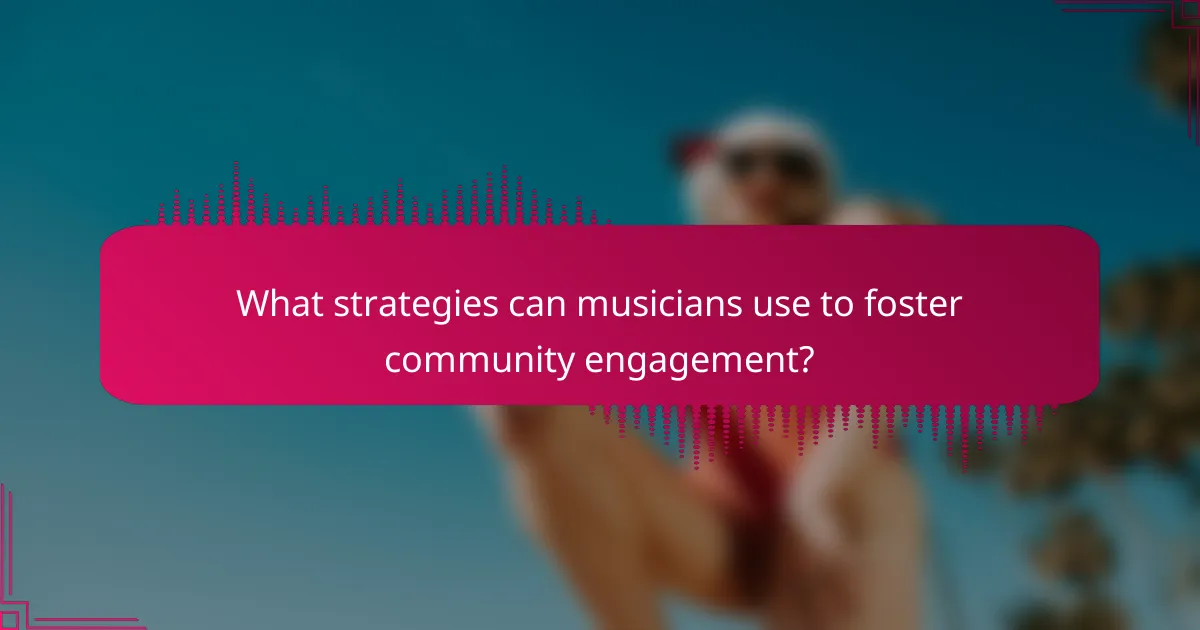
What strategies can musicians use to foster community engagement?
Musicians can foster community engagement through targeted social media marketing techniques. They should focus on authentic storytelling, consistent interaction, and leveraging user-generated content.
Building a personal brand helps musicians connect deeply with their audience. Sharing behind-the-scenes content or personal stories fosters relatability. Engaging with fans through comments and messages promotes a sense of community.
Utilizing live streams allows musicians to interact in real-time, enhancing engagement. These sessions can include Q&A, performances, or discussions about their creative process.
Collaborative projects with other artists or community members can expand reach and strengthen ties. Joint initiatives, such as charity events or local showcases, can attract diverse audiences and create lasting connections.
How can musicians effectively interact with their audience?
Musicians can effectively interact with their audience by leveraging social media marketing techniques. Engaging content, consistent posting, and direct communication foster a strong connection.
Utilize platforms like Instagram and TikTok to share behind-the-scenes moments, live performances, and personal stories. This authenticity resonates with followers and encourages interaction.
Host live Q&A sessions or virtual concerts to create real-time engagement. These events provide opportunities for fans to connect directly, enhancing loyalty.
Analyze audience metrics to refine strategies. Understanding demographics and preferences allows musicians to tailor their content, increasing relevance and engagement.
What are the benefits of collaborating with other artists or influencers?
Collaborating with other artists or influencers enhances audience engagement for independent musicians. It broadens reach, fosters community, and leverages diverse fan bases. This synergy can lead to increased visibility and credibility in the music industry. As a result, musicians can tap into new opportunities and creative collaborations that resonate with their audiences.
How can musicians leverage user-generated content to enhance engagement?
Musicians can enhance engagement by encouraging user-generated content, such as covers or fan videos. This approach fosters community and builds a deeper connection with the audience. Engaging with fans’ creations can increase visibility and create a sense of belonging. For instance, reposting fan content can boost interaction and loyalty.
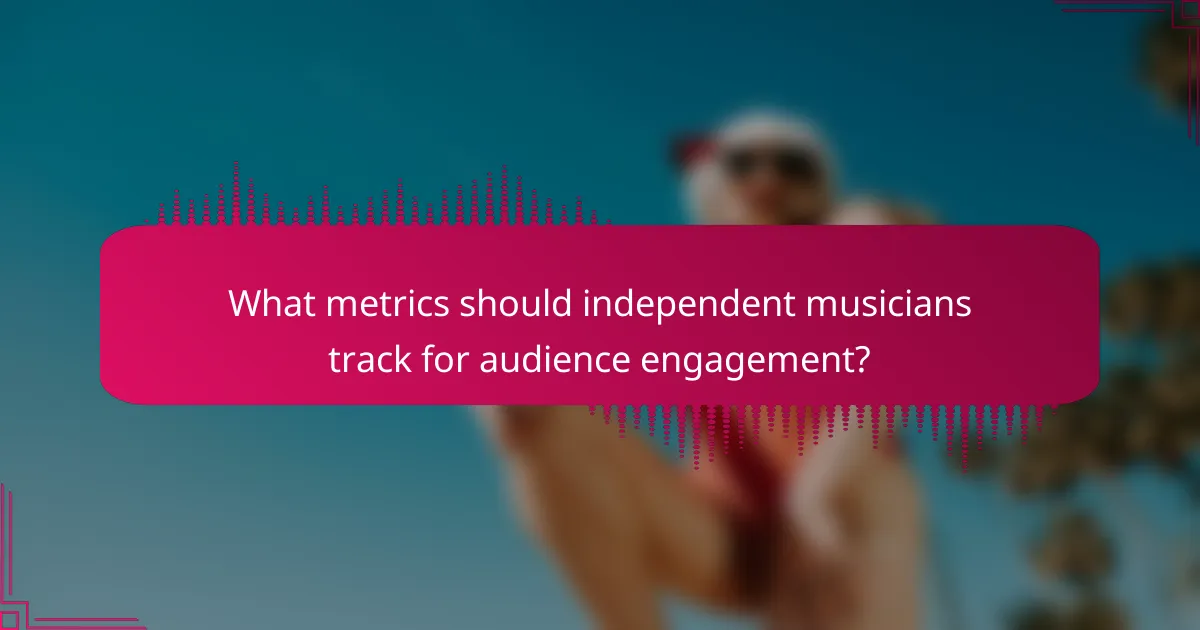
What metrics should independent musicians track for audience engagement?
Independent musicians should track engagement metrics such as likes, shares, comments, follower growth, and click-through rates. These metrics provide insights into audience interaction and content effectiveness.
Likes measure immediate approval, while shares indicate broader reach. Comments offer qualitative feedback, revealing audience sentiment. Follower growth reflects overall popularity, and click-through rates assess the effectiveness of promotional content.
By analyzing these metrics, musicians can tailor their social media strategies to enhance audience engagement and foster a loyal fan base.
Which engagement metrics are most relevant for musicians?
The most relevant engagement metrics for musicians include likes, shares, comments, follower growth, and video views. These metrics provide insights into audience interaction and content effectiveness.
Likes indicate immediate approval, while shares amplify reach. Comments reflect deeper engagement, showcasing audience sentiment. Follower growth tracks overall popularity, and video views measure content consumption. Monitoring these metrics helps musicians refine their social media strategies.
How can musicians analyze their social media performance?
Musicians can analyze their social media performance by tracking engagement metrics, audience growth, and content reach. Focus on likes, shares, comments, and follower demographics to gauge effectiveness. Use analytics tools to identify peak engagement times and popular content types. This data helps refine marketing strategies and enhance audience connection.
What tools can assist in tracking and optimizing engagement metrics?
Analytics tools such as Google Analytics, Hootsuite, and Sprout Social can effectively track and optimize engagement metrics for independent musicians. These platforms provide insights into audience behavior, content performance, and engagement rates. Google Analytics offers detailed website traffic analysis, while Hootsuite and Sprout Social focus on social media metrics. Using these tools enables musicians to refine their strategies and enhance audience interaction.
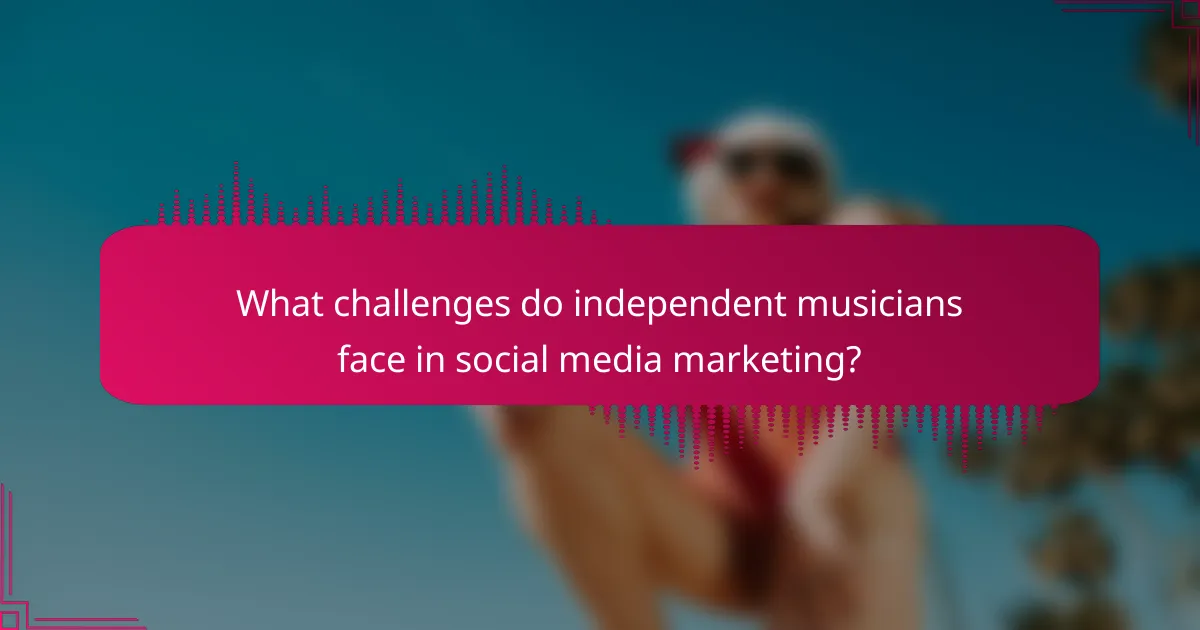
What challenges do independent musicians face in social media marketing?
Independent musicians face several challenges in social media marketing, including limited resources, audience engagement, and content saturation. They often struggle with creating consistent, high-quality content due to time constraints and financial limitations. Additionally, algorithm changes on platforms can hinder visibility, making it difficult to reach their target audience effectively. Competition from established artists and other independent musicians further complicates their marketing efforts. Finally, understanding analytics to gauge audience response is crucial yet often overlooked, impacting their ability to refine strategies for better engagement.
How can musicians overcome algorithm changes on social media?
Musicians can adapt to algorithm changes on social media by diversifying their content strategies. Engaging directly with fans through live streams, Q&A sessions, and behind-the-scenes content fosters loyalty. Utilizing multiple platforms ensures a broader reach, as algorithms vary across sites. Collaborating with other artists can also enhance visibility and introduce musicians to new audiences. Regularly analyzing engagement metrics helps identify what resonates, allowing for agile adjustments to strategies.
What are common pitfalls in social media marketing for musicians?
Common pitfalls in social media marketing for musicians include inconsistent branding, neglecting audience engagement, and failing to analyze performance metrics. Musicians often overlook the importance of a cohesive visual and auditory identity across platforms, which can confuse potential fans. Ignoring direct interaction with followers leads to missed opportunities for building a loyal community. Additionally, without regular assessment of engagement analytics, musicians may struggle to identify what content resonates, hindering growth.
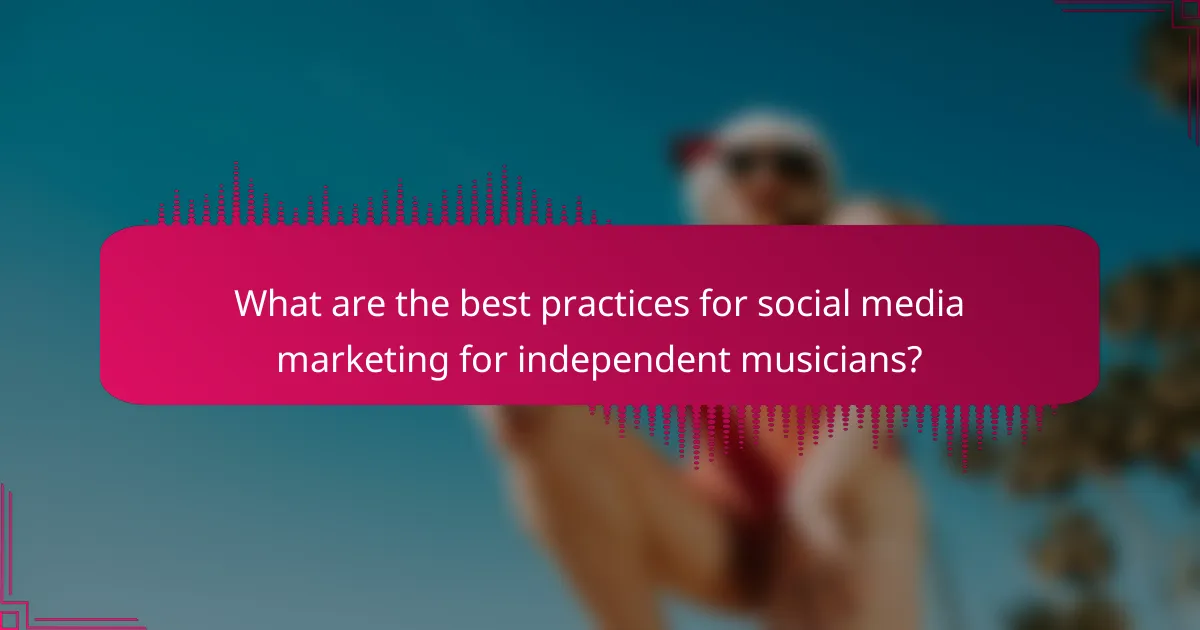
What are the best practices for social media marketing for independent musicians?
Independent musicians can enhance audience engagement through strategic social media marketing practices. Focus on authentic storytelling to connect emotionally with fans. Utilize live streaming to create real-time interactions, fostering community. Consistent posting schedules maintain visibility and engagement. Collaborate with other artists to reach new audiences and diversify content. Use analytics to track performance, adjusting strategies based on audience preferences and behaviors.
How can musicians create a content calendar for consistent posting?
Musicians can create a content calendar by planning posts in advance to ensure consistent engagement. Start by identifying key themes such as new releases, behind-the-scenes content, and fan interactions.
1. Define posting frequency: Decide how often to post on each platform, balancing quality and engagement.
2. Select content types: Choose a mix of videos, images, and text to maintain variety.
3. Schedule content: Use tools like Hootsuite or Buffer to automate posts based on peak audience activity times.
4. Monitor and adjust: Regularly review engagement metrics to refine the calendar and improve reach.
This structured approach enhances audience interaction and builds a loyal following.
What are expert tips for maximizing audience engagement on social media?
To maximize audience engagement on social media, independent musicians should focus on authenticity, consistent interaction, and tailored content. Engaging storytelling fosters connections and encourages shares.
1. Share personal stories to create emotional ties.
2. Post consistently to maintain visibility and relevance.
3. Utilize polls and questions to invite audience participation.
4. Collaborate with other artists to reach new audiences.
5. Analyze engagement metrics to refine strategies.
What common mistakes should musicians avoid in their social media strategy?
Musicians should avoid inconsistency, neglecting audience interaction, over-promotion, and ignoring analytics in their social media strategy. Inconsistency in posting can lead to audience disengagement. Failing to interact with followers misses opportunities for deeper connections. Over-promoting music without providing valuable content can alienate fans. Ignoring analytics prevents musicians from understanding what resonates with their audience.

